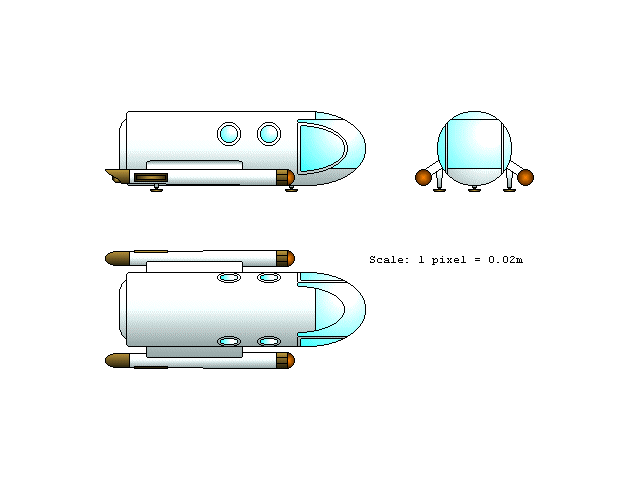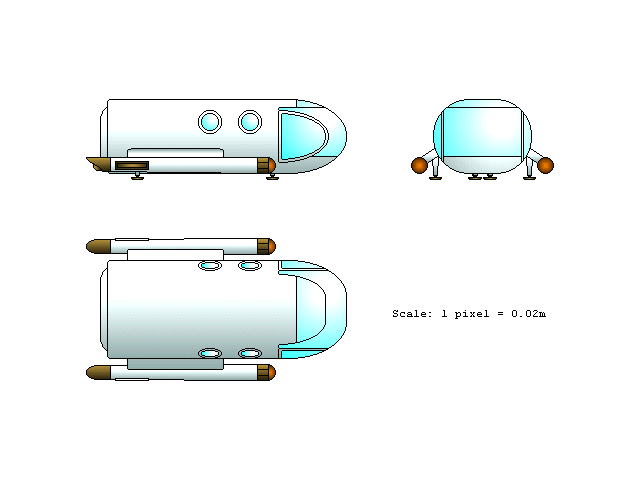
Mark 1 Shuttlecraft
Designer: Robert C. Dunehew E-mail [email protected]

Designer: Robert C. Dunehew E-mail [email protected]
Mark 1 and Mark 1a shuttlecraft
General Specifications:
Length: 5.22m (both)
Width: 2.38m (Mk 1), 2.84m (Mk 1a)
Height: 1.62m (both)
Max Warp: 1.1 (both)
Cruise: 1.0 (Both)
Max. Impulse: 0.125 lightspeed
Crew: 1 (both)
Passengers: up to 4, 6 in an emergency (Mk 1), up to 6, 9 in an emergency (Mk 1a)
Armaments: None.
Type: Transorbital/interplanetary shuttlecraft.
Status: Several thousand built from 2160 to 2205, with approximately one third of production going to Starfleet and the rest sold to civilian concerns. Most were retired in 2225, but there may still be some in operation, though not with Starfleet.
About Ship: As the Romulan war reached its climax, UESPA scientists were working feverishly to develop new technology that would give Earth's forces a decided advantage against the mysterious Romulans. Several ships, when converted for wartime use, had to have their aerodynamic or ballistic landing craft (collectively referred to as aerodynes) removed to make room for fire control and weapons systems. Although introduced too late in the war to make a difference, the Mark 1 and Mark 1a shuttlecraft were, in fact, the first truly compact transorbital vehicles to enter service in the Alpha quadrant.
The Mark 1s were very compact shuttlecraft, both in contemporary terms and by the standards of the day. Although UESPA had equipped the Daedalus class starships with an aerodyne shuttle, even the smallest of these was larger than the Mark 1a, and carried fewer passengers. The new shuttlecraft would carry more passengers and cargo to and from a planetary surface while occupying less space aboard ship. They were even capable of interplanetary travel at low warp velocity. This latter feature allowed an exploration vessel to "cover more ground" during a system-wide exploration mission.
Both shuttles are powered by a Micro-fusion pack that powers the main thrusters, the nacelles, and the newly-developed gravitic repulsorlift drive that allowed VTOL performance with minimal blowdown from the thrusters. Previous designs had either required a long takeoff roll or used direct thrust from the main drives to lift off, which could severely damage the immediate environment. Auxiliary power could be provided by retractable solar cells or the on-board fuel cell unit.
The main thrusters of both shuttlecraft were grouped in an aerospike arrangement at the rear of the fuselage. Sufficient thrust was available to allow the vessel to climb vertically from ground level, like an old-style rocket. More usually the standard procedure was to rise using only the gravitic thrusters, gradually increasing horizontal thrust as the distance from the surface increased, thus minimizing adverse effects to the surface environment. Once the vessel had risen above much of the atmosphere, acceleration to orbital velocity could proceed without the inconvenience of atmospheric drag.
Access to the interior was provided for by two large doors at the front of the cabin, supplemented by a small airlock located in the center of the aerospike engines. This latter entry was not, of course, used while operating the main thrusters. While providing adequate access to crew, these doors did not provide sufficient clearance to allow loading large cargo items. The Mk 1b and Mk 1c addressed this problem by extending the hull and placing the pilot's position in the extreme forward section of the nose. The section containing the pilot's compartment swung open on hinges, allowing unobstructed access to the passenger/cargo cabin.
Several newer designs of shuttlecraft were introduced during the production run of the Mk 1 series, but the Mark 1s themselves were never quite replaced by any of them until production ceased in 2205. Many preferred the Mark 1 series despite its relatively low performance. It was easy and economical to maintain, repair and operate. Starfleet finally retired its Mk 1 shuttlecraft in 2225, but few were scrapped. Most were sold to private concerns for use as interplanetary transportation. There are more than a few Mk 1 shuttles in museums, but there are still quite a few operating as regular transportation in remote areas of the Federation.

Mark 1a Shuttlecraft
Return to the Starship Catalogue.